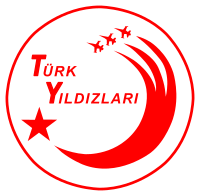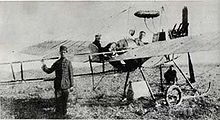Türk Yıldızları
| Türk Yıldızları | |
|---|---|

|
|
| Country: |
|
| Currently used aircraft type: | Northrop F-5 |
| Sponsor: | Turkish Air Force |
| Base airfield: | Konya Airfield |
| Colours: |
Red , white |
| Weblink: | www.turkyildizlari.tsk.tr |
Türk Yıldızları (The Turkish Stars) or Turkish Stars are a Turkish aerobatic team based in Konya . This acrobatic team ( Akroteam for short , Turkish akrotim ) of the 134th fleet of the Turkish Air Force ( Türk Hava Kuvvetleri ) currently consists of eleven pilots. Eight Northrop F-5 combat aircraft are used for the flight demonstrations . It is one of the oldest aerobatic teams that flies supersonic aircraft. In addition to the Türk Yıldızları, the Turkish Air Force also operates the Solo Türk , a solo acro team that flies an F-16.
history
Shortly after it was founded in 1911, the Turkish Air Force experienced a period of conflict and war. These began with the Balkan Wars , continued in World War I and then culminated in the Turkish War of Liberation .
The Turkish air force achieved its first successes in Yemen , the Caucasus and in the Turkish liberation struggle led by Ataturk against the victorious powers of the First World War. The history of Turkish aerial acrobatics begins in 1914 when the Turkish Air Force tried to develop further in order to be able to compete with other nations in this field. On March 5, 1914, the pilot Lieutenant Fazıl Bey was the first Turkish pilot to perform a vertical spin at a height of 400 m. Other pilots followed his example with different maneuvers.
The first official acrobatic flight exercises were carried out in 1926 within the Air Force School (Hava Harp Okulu). From the successful group under the leadership of the flight instructor Leutnant Enver Akoğlu, successful pilots like Leutnant Tekin Arıburun emerged through the good training.
From July 1, 1932, the air force became an independent unit of the Turkish armed forces and from 1933 used blue as the weapon color, which is a symbolic color for the Turks.
After the establishment of the Turkish Republic , the development of the air force continued. In 1940 she already owned over 500 aircraft, all of which were placed under one command on January 31, 1944 ("Türk Hava Kuvvetleri Komutanlığı").
One of the important changes in the history of the Turkish Air Force was the switch from propeller aircraft to jet aircraft after NATO membership in 1952.
In 1950 the first Turkish jet planes were put into service, with the 191st, 192nd and 193rd fleets ( Turkish filo) being Turkey's first fleets. This year the first Turkish public aerobatics began.
First acro team
Shortly after the introduction of jet aircraft in the Turkish Air Force in 1952, the first acroteam was founded in accordance with today's technological international standards under the name "Milli" ( German national). The first Akroteam flew with F-84G Thunderjet , which were stationed at the 9th Air Force Base in Balıkesir (Balıkesir 9n. Hava Üs Komutanlığı). The place is also considered to be the first jet base in Turkey. The team with the callsign "Milli" carried out many successful flights in Turkey and other countries such as Italy and Belgium between 1952 and 1962 and became world famous.
Second acro team
The name of the second acroteam founded in 1955 in the 4th Eskişehir Air Force Base (Eskişehir 4th Hava Üs Komutanlığı) was "Uçan Kuğular" ( German: Flying Swans). This acroteam flew F-86E Saber jet aircraft in its ten-year service life . The planes were painted red and white and had a swan motif at the top. In 1964 they found general recognition with their 9 and 12 aerobatics.
Third acroteam
The acroteam with the call sign "Akrep" ( dt. Scorpion) of the 8th Diyarbakır Air Force Base was founded in 1957 and was used until 1959 as an aerobatic team. The Republic F-84G aircraft type was used in domestic and Pakistani performances . The F-84G was a further development based on the F-84E and could be air-fueled.
Fourth acro team
The Akroteam with the callsign "Yarasalar" ( German bats), which was founded in 1964 in the 5th main air force base in Merzifon (Merzifon 5th Ana Jet Üs Komutanlığı), used aircraft of the type F-86E Saber . These models, which had been in service for two years, were painted black and provided with white decorative elements. They performed 5, 9 and 12 acrobatic flights.
Fifth acro team
This acroteam, founded in 1966 and called "Kartal" ( German eagle) until 1971, was called "Coşkun" ( German lively, enthusiastic, passionate, stormy) in 1971 . The reason for this was the death of First Lieutenant Coşkun Turan on March 21, 1971 during a flight. The aircraft type of the Akroteam founded in the 6th main air force base in Bandırma (Bandırma 6th Ana Jet Üs Komutanlığı) was the F-5A Freedom Fighter . Among other things, the team took part in an aerobatic performance in Italy in 1971.
Sixth acro team
This acro team was re-established in 1971 at the 5th Main Air Force Base in Merzifon for a performance to celebrate the 900th anniversary of the Malazgirt Victory in 1071. The acroteam used the F-5A Freedom Fighter for this occasion .
Acroteams were no longer used regularly between 1971 and 1992.
Seventh acro team
After 20 years, the Turkish Air Force decided to use regular acro teams again and start new projects with them. Under General Halis Burhan, the project to form a new acro team was launched on September 11, 1992 at the 3rd main air force base in Konya (Konya 3rd Ana Jet Üs 132th Silah Taktikler ve Standardize Filo Komutanlığı).
On November 7, 1992, it was decided to incorporate four Northrop F-5s for the new Akroteam in the 132nd Fleet and to train four pilots for the task. With Halis Burhan's approval of the new detailed flight plans, the training flights began, which ended with the training of pilots (at home and abroad) as aerobatic pilots in January 1993.
The team then went on training trips and other seminars in Canada, Great Britain and Italy. On April 27, 1993, the NF-5 were brought to the highest level in terms of safety in order to be able to perform the most difficult maneuvers with them. The final step was the installation of a new smoke system and the painting of the aircraft.
On June 18, 1993, the Turkish acro team under the new name Türk Yıldızları (Turkish Stars) carried out the first air show for ministers and invited guests after the shooting championships of the Turkish Air Force at the 4th main air base in Ankara (Ankara Akıncı 4th Ana Jet Üs Komutanlığı). After their good performance was recognized, the “Turkish Stars” received fleet status and became the youngest supersonic aerobatics team (süpersonik akrobasi takım) in the world.
In August 1993, maintenance work began in Eskişehir (Eskişehir 1. Hava İkmal Bakım Merkez Komutanlığı) and, in parallel, the training flights. Nine NF-5 aircraft and one NF-5B were integrated into the fleet.
The first air show with eight aircraft took place on March 30, 2004. The season had its first big sensational appearance in Europe in July 1997 at the Royal International Airtattoo in Fairford, Great Britain. On July 3, 2004, the 200th presentation of the "Turkish Stars" took place in Rize . Today they are among the best aerobatic teams in the world and are the first team in the world that was allowed to show the full flight program again without restrictions over German soil at the ILA Berlin in 2012, after the Ramstein flight accident in 1988.
Web links
- Website of the Türk Yıldızları (tr / en)





